
 |
Do example sentences work in direct vocabulary learning?
Zhang Baicheng
Chongqing Jiaotong University, China
In the present study of language learning, three presentation modes (varying from providing or not providing example sentences by the teacher and by the students themselves) have been utilised to examine the effectiveness of using example sentences in vocabulary presentation and learning activities. The study is of 58 English majors as the subjects and two tests were performed one hour and one week after the relevant presentations, utilising one of three presentation modes. Supported by the two major findings from data analysis, the study reaches the conclusions that: 1) using example sentences in vocabulary learning promotes learners' vocabulary learning and retention; 2) the ways of using example sentences influences learners' vocabulary learning and retention effects as well. Generally, the effect is better when learners make their own example sentences than when the sentences are randomly provided by the teacher. The conclusions indicate that example sentences do work in direct vocabulary learning in ESL and EFL contexts.
The keyword method "helps to facilitate the linking of a word's form with its meaning" (Hulstijn, 1997), and it has a facilitating role in vocabulary learning (Desrochers et al, 1991; Levin et al, 1992; Ellis & Beaton 1993; Hogben & Lawson, 1994, etc.). However, some researchers argue that the keyword method has attracted little attention because "it can be successfully applied with only a minority of vocabulary items, such as with words referring to objects that can be perceived visually" (Hulstijn 1997).
Defining is another method to teach and learn vocabulary directly. Some studies (Flowerdew, 1992; Ellis 1995; Brett, Rothlein & Hurley, 1996) show that providing simple and clear definitions of the target words is effective for vocabulary learning. Three categories of definitions were introduced (Nation, 2001): formal definition (consisting of the term - the word to be defined, the class it fits into and its defining characteristics), semi-formal definitions (consisting of only the term and the characteristics), and substitution (when a word, word part, phrase or phrases with a similar meaning is used to define the term).
The effectiveness of semantic elaboration on vocabulary teaching and learning has been studied, and researchers find that it is effective for long-term retention (Hague, 1987; Machalias, 1991). Four techniques for semantic elaboration have been summarised in Sökmen (1997): semantic feature analysis, semantic mapping, ordering and pictorial schemata [1].
Systematic instruction plus contextualised reading has been proved effective. Studies have found "positive evidence in support of explicit vocabulary instruction in an ESL setting" (Zimmerman, 1994; Paribakht & Wesche, 1997), and suggest that direct vocabulary instruction accompanied by a moderate amount of reading lead to significant gains in vocabulary knowledge (Coady, 1997).
Computer-assisted vocabulary teaching and learning (CAVTL) is a promising method. Harrington (1994) described a program which explicitly develops and monitors form-based and meaning-based links between words. Hubbard, Coady, Graney, Mokhtari and Magoto (1986) and Cobb (1997) reported studies of computerised programs providing learners with example sentences, or short definition and other information of the target words, and found the programs facilitate vocabulary gains. Thurstun and Candlin (1998) and Schmitt (2000) explored the using of concordances in vocabulary learning, and reported that it was advantageous.
Obviously, the approaches and methods reviewed above contribute to the effectiveness of direct (intentional) vocabulary teaching and learning. What interests us in the present research are the two studies (Hubbard, et al, 1986; Cobb, 1997) using example sentences to present target words. In these two studies, computerised programs were designed, and by presenting learners with example sentences (or short definitions, example sentences and the opportunity to type in a keyword mnemonic), learners were required to fulfill some tasks including choosing the meaning for the target words and identifying a form to fit the example sentences where the target word has been replaced by a blank. The studies conclude that such computerised programs facilitate learners' vocabulary learning.
Based on the two studies reviewed above, we planned to explore the role of example sentences in direct English vocabulary learning. However, instead of using computerised programs, the present study focuses on three traditional presentation modes because they are more typical and widely adopted in the EFL context in China. To be exact, the present study attempts to answer two questions:
| Factor | Levels | Treatments |
| Presentation Modes | 1 (Presentation Mode I) | 1 (the short-term memory test) |
| 2 (the long-term memory test) | ||
| 2 (Presentation Mode II) | 1 (the short-term memory test) | |
| 2 (the long-term memory test) | ||
| 3 (Presentation Mode III) | 1 (the short-term memory test) | |
| 2 (the long-term memory test) |
The experiments were done during classes over 3 weeks, and all the 58 subjects were made to learn the 3 groups of words (which had been proved to be similar in learning difficulty) using 3 presentation modes, and tested twice.
In the experiments, the target words were presented to the subjects for about twenty minutes, using a certain presentation mode respectively, then the subjects were tested twice, namely the short-term memory test (held one hour after the presentation) and the long-term memory test (performed one week after the presentation). The test paper involved two types of commonly used vocabulary testing forms in China: giving the Chinese equivalent for the English word, and giving the relevant English word according to the Chinese meaning (see Appendix 3).
For those correct but imprecise answers or partially correct answers (with one or two letters misspelt), we subtracted some points from the full mark for each word in accordance with the degree of the mistakes they made. Finally, in dealing with the decimal of the total score of each test paper, we adopted the rounding off method for the convenience of data recording and processing, ie, if the decimal was equal to or larger than 0.5, it was added as one, otherwise, it was ignored.
| Forms of tests | Score for each correct answer | Decimal treatment for total score | |
| 1 | Writing the Chinese equivalents (10 words) | 6 points | Rounding off method |
| 2 | Writing the English words (5 words) | 8 points | |
| Short-term memory tests | Long-term memory tests | ||||||
| PM | Mean | Std. deviation | Variance | PM | Mean | Std. deviation | Variance |
| 1 | 46.33 | 17.731 | 314.379 | 1 | 25.08 | 12.041 | 144.994 |
| 2 | 46.18 | 18.458 | 340.712 | 2 | 28.13 | 17.807 | 317.087 |
| 3 | 40.30 | 14.722 | 216.728 | 3 | 33.03 | 11.176 | 124.897 |
| Total | 44.27 | 17.136 | 293.659 | Total | 28.74 | 14.254 | 203.185 |
Table 3 shows that the mean vocabulary retention amount of the short-term memory test by using Presentation Mode I is the most (Mean=46.33), the one when using Mode II is a little less (Mean=46.18), and that by using Mode III is the least, (Mean=40.30) which shows that the vocabulary learning and retention effects by utilising the three presentation modes decrease gradually; while in long-term memory tests, when using the three presentation modes, vocabulary learning and retention effects ameliorate progressively: the vocabulary retention amount when utilising presentation mode I is the least (Mean=25.08), the one when adopting Mode III is the most (Mean=33.03), and that by using Mode II lies in the middle (Mean=28.13).
| PM | Short-term memory tests | Long-term memory tests | ||||||
| Mean difference | Std. error | Sig. | Mean difference | Std. error | Sig. | |||
|
.15 6.03 | 3.812 3.812 | .999 .258 | -3.05 -7.95 * | 3.399 2.598 | .750 .009 | ||
|
-.15 5.88 | 3.812 3.812 | .999 .276 | 3.05 -4.90 | 3.399 3.324 | .750 .372 | ||
|
-6.03 -5.88 | 3.812 3.812 | .258 .276 | 7.95 * 4.90 | 2.598 3.324 | .009 .372 | ||
| Note: 1 = PM 1; 2 = PM 2; 3 = PM 3. * The mean difference is significant at the .05 level | ||||||||
As is shown in Table 4, the short-term memory tests results when using the three presentation modes are different, but the degree of the difference between any two tests has not been statistically significant (Sig. > .05); while in the long-term memory tests, the three test scores are variant when utilising the three presentation modes respectively, and the variation degree between tests 1 and 3 reaches a significant level (Sig.=.009, < .05), which reveals the vocabulary learning and retention effect in the long-term memory test when adopting Mode III is much better than that when using Mode I.
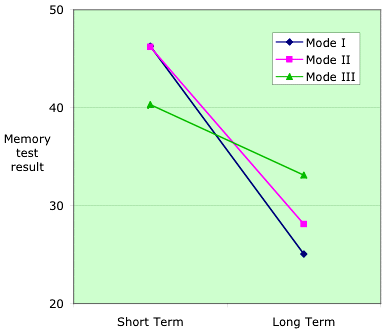
Figure 1: Comparison of memory fading tendencies
In this figure, the three lines represent the memory-fading tendencies in using the three Presentation Modes (I, II and III), ie, the fading degrees of the vocabulary retention between the short-term and the long-term memory tests. The figure shows that the memory fading degree by using Mode I is the greatest among the three, and the one by using Mode III is the least. The degree of memorisation reduction by using Mode II sits between the two. The memory-fading tendencies by using the three modes proves the effectiveness of using example sentences in vocabulary learning and retention
According to elaboration theory, providing example sentences is important in vocabulary presentation. On the one hand, while it increases the information processing load, it ensures that learners can effectively elaborate the relevant syntactic information of the target words, and thus the target words can be stored in long-term memory (entering the mental lexicon) more quickly, which leads to a better access to them (for later activation and retrieval). On the other hand, by elaborating syntactic information of the target words, more information and possible paths are available to retrieve the vocabulary information stored.
Furthermore, writing example sentences encourages learners to achieve their intentional elaborating behavior, and the realisation of this actually enhances the elaboration effects, and thereby the degree of the vocabulary information processing is deepened, which leads to a more effective retention (storage) of the vocabulary information and a lower rate of memory-fading. Therefore, the vocabulary learning and retention effect is better than that without producing example sentences.
As for the second finding, we offer our preliminary interpretations as follows.
First, memory-fading naturally occurs as time passes. After the input (new information) has been received, it is stored in the short-term memory temporarily to be forgotten or processed further to enter the long-term memory, and in this process, information loss happens at various speeds according to different degrees of processing (elaboration).
The test scores decrease gradually in turn as the information processing loads increase, which is natural because increasing the information processing load is actually increasing a human being's cognitive effort. Increasing cognitive effort probably leads to the increase of learning difficulty, and may lead to poorer vocabulary learning and retention effects due to the probable decrease of internalising vocabulary learning in the new language. To be exact, the cognitive effort needed for learning and memorising the target words by using Mode III is much greater than that devoted to the task when using Mode I and Mode II, that is, the subjects need to pay greater effort for the vocabulary learning when required to write their own example sentences, and comparing with this, some extra but not much cognitive effort is needed for the learning activity when using Mode II with the example sentences provided by the teacher.
Then, as we know, memory fading occurs as time goes by, and the rate of the fading varies due to the information processing depth, the effectiveness of elaboration and some other factors. By using Mode III, subjects are required to make their own authentic example sentences, which needs more cognitive effort given for the vocabulary learning activity and this leads to much deeper information processing and more effective elaboration. Therefore a much more solid memorisation effect was achieved, and this ensures the slightest amount of memory fading among the three, thus the best vocabulary retention in the long-term memory tests can be achieved. Compared with other modes with little or no elaboration, we predict that the longer the time passes, the greater (more significant) the retention difference of the learning activities will be.
The present study has some implications in vocabulary teaching and learning practice, which makes us believe that incidental vocabulary acquisition and direct (intentional) vocabulary teaching and learning are complementary activities, and the latter seems to be more important (at least in some stages of English learning) in EFL contexts. In direct vocabulary teaching and learning, many approaches and methods can be adopted, and the current study provides evidence for using example sentences in vocabulary learning, and emphasises that example sentences should be included as an essential component in direct vocabulary teaching and learning. To be exact, the study may shed some light on vocabulary pedagogy in EFL contexts:
Then, the assignment of the subjects is also a limitation. The 58 subjects have not been selected through true randomisation, and 32 of them have just been selected from one class since it is almost impossible to select a certain number of subjects from different classes or randomise the assignment of subjects to different experimental groups, which would need to reorganise classes and thus may probably disturb the ongoing programs and the teaching and learning order of the school.
Brett, A., Rothlein, L. & Hurley, M. (1996). Vocabulary acquisition from listening to stories and explanations of target words. The Elementary School Journal, 96, 415-422.
Carter, R. & M. McCarthy. (1988). Developments in the teaching of vocabulary: 1945 to the present day. In R. Carter & McCarthy, M. (Eds.), Vocabulary and language teaching. New York: Longman Group UK Limited.
Coady, J. (1997). L2 vocabulary acquisition. In J. Coady & T. Huckin (Eds), Second language vocabulary acquisition. Cambridge: CUP.
Cobb, T. (1997). Is there any measurable learning from hands-on concordancing? System, 25, 301-315.
Desrochers, A., DeRoy Wieland, L., & Cote, M. (1991). Instructional effects in the use of the mnemonic keyword method for learning German nouns and their grammatical gender. Applied Cognitive Psychology, 5, 19-36.
Ellis, N. & Beaton, A. (1993). Factors affecting the learning of foreign language vocabulary: Psychology linguistic determinants. Language Learning, 43, 559-617.
Ellis, R. (1995). Modified oral input and the acquisition of word meaning. Applied Linguistics, 16, 409-441.
Flowerdew, J. (1992). Definitions in science lectures. Applied Linguistics, 13, 202-221.
Hague, S. A. (1987). Vocabulary instruction: What L2 can learn from L1. Foreign Language Annals, 20(3), 217-225.
Harrington, M. (1994). CompLex: A tool for the development of L2 vocabulary knowledge. Journal of Artificial Intelligence in Education, 5, 481-499.
Hogben, D. & Lawson, M. J. (1994). Keyword and multiple elaboration strategies for vocabulary acquisition in foreign language learning. Contemporary Educational Psychology, 19, 367-376.
Hubbard, P., Coady, J., Graney, J., Mokhtari, K. & Magoto, J. (1986). Report on a pilot study of the relationship of high-frequency vocabulary knowledge and reading proficiency in ESL readers. Ohio University Papers in Linguistics and Language Teaching, 8, 48-57.
Hulstijn, J. H. (1997). Mnemonic methods in foreign language vocabulary learning-theoretical considerations and pedagogical implications. In J. Coady & T. Huckin (Eds), Second language vocabulary acquisition. Cambridge: CUP.
Levin, J. R., Levin, M. A., Glasman, L. D. & Nordwall, M. B. (1992). Mnemonic vocabulary instruction: Additional effectiveness evidence. Contemporary Educational Psychology, 17, 156-174.
Machalias, R. (1991). Semantic networks in vocabulary teaching and their application in the foreign language classroom. Babel: Journal of the Australian Modern Language Teachers' Association, 26(3), 19-24.
Nation, I. S. P. (2001). Learning vocabulary in another language. Cambridge: Cambridge University Press.
Paribakht, T. S & Wesche, M. (1997). Vocabulary enhancement activities and reading for meaning in second language vocabulary. In J. Coady & T. Huckin (Eds), Second language vocabulary acquisition. Cambridge: CUP.
Schmitt, N. (2000). Vocabulary in language teaching. Cambridge: Cambridge University Press.
Sökmen, A. J. (1997). Current trends in teaching second language vocabulary. In N. Schmitt & M. McCarthy (Eds), Vocabulary: Description, acquisition and pedagogy (pp.237-257). Shanghai: Shanghai Foreign Language Education Press.
Thurstun, J. & Candlin, C. N. (1998). Concordancing and the teaching of the vocabulary of academic English. English For Specific Purposes, 17, 267-280.
Yu Minhong. (1999). A selection of GMAT vocabulary. Beijing: World Knowledge Press.
Zimmerman, C. B. (1994). Self-selected reading and interactive vocabulary instruction: Knowledge and perceptions of word learning among L2 learners. PhD dissertation, University of Southern California, Los Angeles.
| perish | tweed | cremate | succumb | sprawl |
| haggle | sponge | smirk | cookery | impersonate |
| groom | mob | flush | grinder | maid |
| jubilant | pretext | certify | greasy | potter |
| preach | potent | coral | upheaval | minimize |
| surpass | fluent | vitality | converge | javelin |
| impetus | forcible | jetty | scarcity | outpatient |
| scrawl | outlive | unroll | conserve | pier |
| trifle | slipper | excavate | disarray | inexorable |
| cringe | encase | suffocate | pouch | prolong |
| gnaw | glint | messy | mellow | glacier |
| arid | dredge | drench | archaic | exalted |
| creepy | expatriate | lunatic | jaunty | kudos |
| froth | manicure | ointment | treble | havoc |
| slacken | frolic | expedient | prelude | diabetic |
| hassle | slit | languish | incongruous | judicious |
| mandatory | ornate | hoax | manifest | ordinance |
| sibling | petal | directorate | primate | succinct |
| trivia | malicious | lukewarm | lyrical | incredulous |
| snipe | knead | hijack | fresco | extrovert |
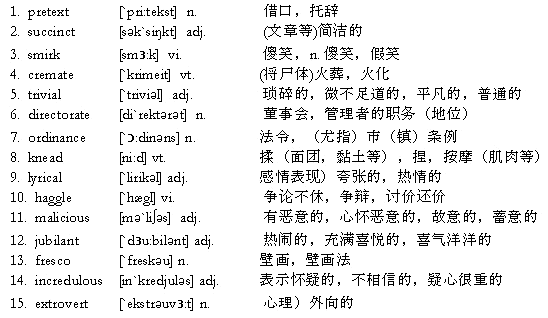
Group 2
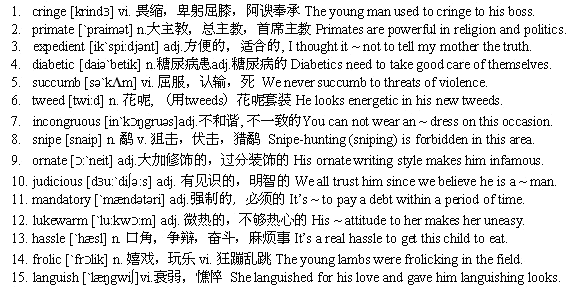
Group 3
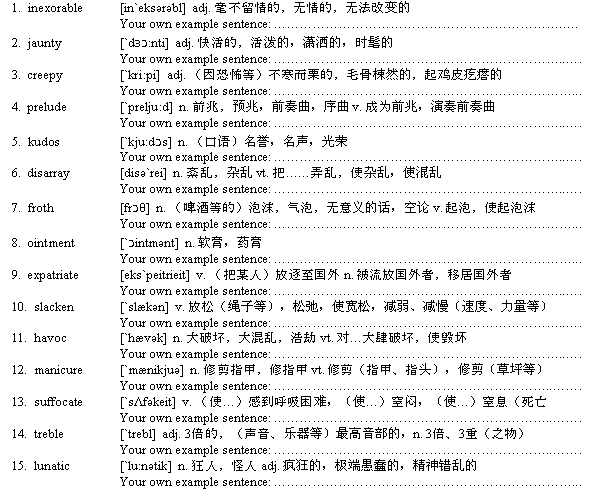
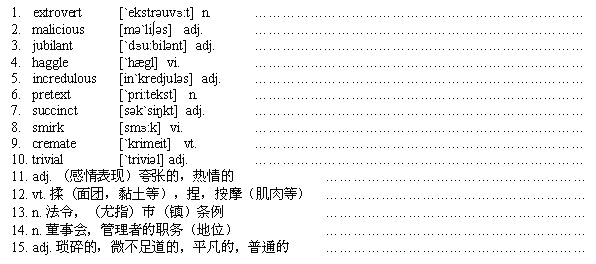
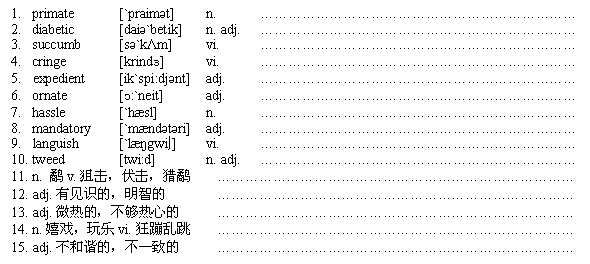
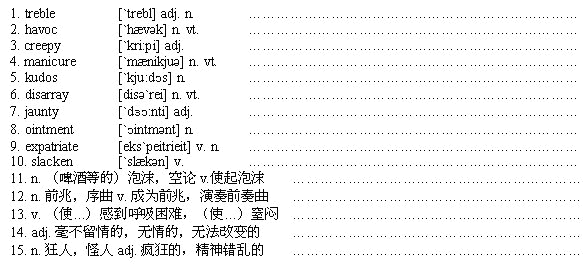
| Author: Zhang Baicheng is an associate professor of English and Vice Director in English Language Department, School of Foreign Languages, Chongqing Jiaotong University, China. His research interests include second language acquisition, corpus linguistics and foreign language teaching. Email: zhangbc@cqjtu.edu.cn
Please cite as: Zhang, B. (2009). Do example sentences work in direct vocabulary learning? Issues In Educational Research, 19(2), 175-189. http://www.iier.org.au/iier19/zhang.html |